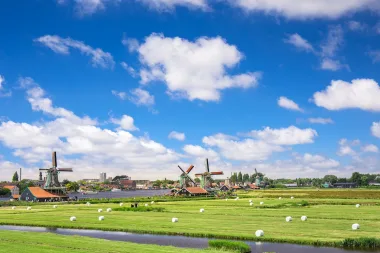Last Updated on November 11, 2025 by Ecologica Life
What happens when we pair human curiosity with machine-scale reasoning? Recent research suggests that we are entering an era of true collaboration between humans and artificial intelligence.
In two recent studies, a specialised AI system developed by Google LLC didn’t just assist research – it operated as a genuine partner in the discovery process. In one case, it proposed drug candidates that showed anti-fibrotic activity in a lab model of chronic liver disease. In another, it independently arrived at a biological mechanism of bacterial gene transfer that had taken human scientists years to decode.
Why are we at Ecologica.life interested in such a development, especially in the field of AI? Well, it points to a potential paradigm shift: human + AI partnerships in bioscience, with implications for medicine, ecology, biotechnology and more.
In this article, we’ll explore what the limits are of traditional research and discovery, as well as the challenges modern researchers face when pushing the boundaries of scientific knowledge. We will then look into two case studies of how AI has aided researchers, and consider the implications of this for other fields. Finally, we will discuss the challenges and ethical considerations of using AI in research. I hope you enjoy reading it as much as I enjoyed writing it!
Table of Contents
The Problem: Limits of Traditional Discovery
Biomedical science is becoming so large and complex that it is increasingly difficult for human teams alone to work with it. The volume of published literature, the diversity of data types, and the cross-disciplinary demands all create significant bottlenecks:
- Take drug discovery for instance: many conditions – such as liver fibrosis – have eluded effective therapy because current models fail to mimic human physiology well.
- Or consider microbial evolution: the mechanism by which genetic elements move across species can be hidden within layers of molecular biology, requiring years of painstaking experimental work to reveal.
In short: human scientists still carry the heavy load of creativity, intuition and experimentation – but the sheer scale of interconnectedness of modern biology makes cutting-edge research extremely challenging.
These challenges explain why researchers are increasingly turning to AI not just as a tool, but as a thinking partner capable of helping to decode biological complexity.
Research Highlight: What the AI Did
To test whether AI can reason like a scientist, Google’s research team developed a collaborative system based on their Gemini 2.0 model — and the results were remarkable.
The following two case studies illustrate how the AI ‘co-scientist’ worked.
1. Tackling Liver Fibrosis
In a study published in Advanced Science, researchers asked the Google AI system to explore epigenomic mechanisms in liver fibrosis – namely, how chemical changes to gene regulation (not changes in the DNA sequence itself) might be therapeutic targets.
The AI system is described as a multi-agent setup built on top of the gemini 2.0 large language model (LLM), where different agents (Generation Agent, Reflection Agent, Ranking Agent, Evolution Agent, and Meta-review Agent) cooperate within a scientist-in-the-loop model.
For the liver project:
- The human researchers provided a prompt: area (epigenomic effects in liver fibrosis) + experimental methods (use of hepatic organoids).
- The AI proposed three classes of epigenomic regulators as promising drug targets: histone deacetylases (HDACs), DNA methyltransferase 1 (DNMT1), and bromodomain protein 4 (BRD4).
- Experimental testing in human hepatic organoids (3D stem-cell-derived mini livers) revealed that HDAC inhibitors and BRD4 inhibitors showed strong anti-fibrotic effects. One of the compounds, Vorinostat (already FDA-approved for cancer), suppressed fibrosis and stimulated healthy liver-cell growth.
- Interestingly, two other drug targets chosen by human researchers (based on more extensive prior literature) did not reduce fibrosis in the same model – suggesting that the AI identified leads that human researchers had overlooked.
2. Cracking a Microbial Mystery
In a second demonstration, published in Cell, the AI tackled the puzzle of how identical phage-inducible chromosomal islands (cf-PICIs)1 appear across different bacterial species – despite the fact that the phages they rely on for mobilisation usually infect only narrow host-ranges.
Humans had solved the mechanism (“tail piracy” mechanism: tailless DNA-filled capsids hijacking other phage tails) after a decade of work.
The AI was given only publicly available data before the human discovery. It generated hypotheses; its top suggestion was that the cf-PICIs exploit “capsid-tail interactions” to broaden host range – almost precisely the human-determined mechanism.
The fact that the AI arrived at this conclusion independently and quickly is striking, as it demonstrates reasoning rather than just pattern-matching.

| Study | Field | Human Timeframe | AI Timeframe | Key Outcome |
|---|---|---|---|---|
| Liver Fibrosis | Biomedical | Ongoing drug search | Weeks | Identified HDAC/BRD4 inhibitors with strong effects |
| Microbial Gene Transfer | Microbiology | ~10 years | Days | Independently deduced “tail piracy” mechanism |
Implications: What This Means for Ecology, Health & Sustainability
Accelerated discovery
For fields like environmental science, biotechnology and health, combining human insight with AI reasoning could significantly speed up breakthroughs. Instead of waiting years for trial-and-error iterations, AI-augmented workflows may cut the time from idea to experiment.
Cross-disciplinary edge
Complex problems – like how pollutants influence microbial communities, or how plant-microbe interactions shift under climate stress – often span many domains. AI systems that scan literature, propose hypotheses, and suggest experiments can help bridge those gaps.
Human-AI partnership, not replacement
Importantly, the researchers emphasise that AI does not replace human judgement. The quality of publicly available data limits what the AI can do. Moreover, humans are still needed to evaluate which leads to pursue.
In short, human domain expertise, creativity, and ethics remain central.
Challenges & Ethical Considerations
- Data quality & bias: The system’s output is only as good as the data it draws on. Publication bias, incomplete datasets, or poor experimental documentation may mislead the AI.
- Experimental validation bottleneck: While generating hypotheses is fast, testing them in labs is still slow, expensive, and resource-intensive. Prioritisation remains critical.
- Interpretability & transparency: As AI becomes more involved in hypothesis generation, how we audit its reasoning becomes important. Can we trace why it proposed a given mechanism or drug?
- Equity and access: High-powered AI systems may widen divides between well-funded labs and under-resourced ones.
- Ethical use in bioscience: As AI helps propose mechanisms in microbiology or gene transfer, oversight is needed to ensure dual-use risks are considered (e.g., harmful microbial engineering).
Environmental Impact of Artificial Intelligence
Conclusion
The work of Google’s AI co-scientist signals a significant evolution: a shift from tools that assist scientists to systems that collaborate in the process of discovery. For you, our Ecologica.life readers, this hopefully means that the future of research (and humanity) will be human plus machine, not human versus machine. Together, we could unlock faster, more integrative insights into a wide range of fields, including bioscience and sustainability — and perhaps even astronomy. Food for thought: maybe this AI revolution will allow us to explore and live beyond the Moon and perhaps even beyond our solar system.
The question now isn’t whether AI will change science, but how we can guide this change responsibly.
What do you think? How might AI-driven discovery reshape the research you care about, and what questions should we be asking now?
- A small segment of bacterial DNA that can hijack bacteriophage machinery to transfer itself between bacteria. Some PICIs, such as cf-PICIs (“capsid-forming” PICIs), form their own viral particles and play a major role in horizontal gene transfer. ↩︎







